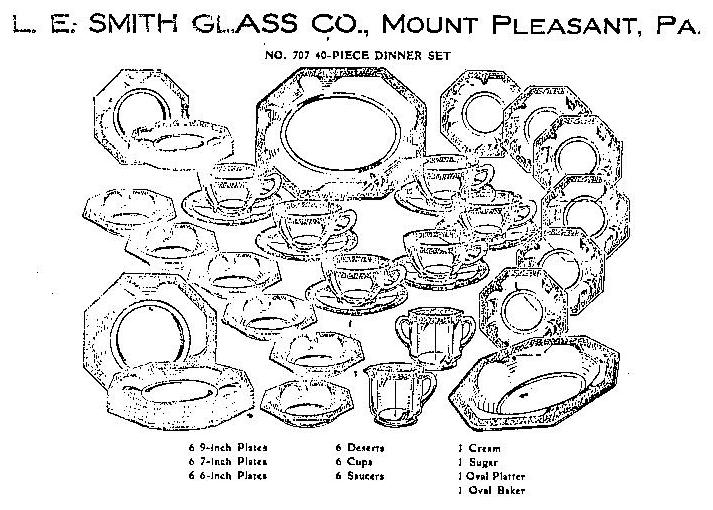National Depression Glass Association
Preserving America's Glass Manufacturing Heritage
L. E. Smith Company
by Sandy Stout Olander
Rainbow Review Glass Journal - February 1972
Yes, we have another company that made our beloved depression glass, the little heard of glass house in Mount Pleasant, PA, the L E. Smith Glass Co. Little heard of, that is, by us depression glass collectors.
Note on the Smith catalog sheet (at end of article) of 1920-30 era, depicting our PEBBLED BAND band pattern, that an oval or oblong serving dish, was referred to as a baker. The L E. Smith Company produced about 95% of ALL black and ebony opaque glass in the 1915-30 era; this does NOT INCLUDE the glass made by the better quality companies such as CAMBRIDGE, FOSTORIA,HEISEY (only made it on an experimental basis), and DUNCAN AND MILLER and other finer quality glass houses. The L. E. Smith Glass Company issued standard colors such as pale pink, light green, crystal (clear), amber, and also black, ebony end black opaque, canary and amethyst. The canary may be the hue of topaz, or lean toward the vaseline coloring.
As many of you know, L. E. Smith Glass Company is reknowned among collectors as being one of the manufacturers of our collectible candy containers; in fact, the L. E. Smith Campeny carried a vast line of novelties and specialty items. In ths 1920 period they purchased the Greensburg Glass Factory, mainly for their glass mixing bowl line, which had built up a tremendous volume. Many of the records of the Greensburg plant are now lost or mlsplaced end a continuous history is hard to document at the present time, however, if you are an avid collector of early American pressed glass and figural bottles, you will no doubt have heard the name of Greensburg Glass Company as it goes way back in our American heritage to the post 1850 period of collecting.
The L. E. Smith Glass Company appears to be ahead of its time on coloring their patterns and novelties - most companies did not issue the black amethyst coloring, for instance, unlil the 1930-32 period. However, Smith has documented its patterns in black amethyst back to 1920 or a little before. Topaz was another color that was popular in the 1931-33 era, popular that is, by the issuance of Florentine in Topaz, and other dinnerware compositions by competing factories. However Smith started issuing their Canary color in the 1920 era, a whole decade before it was assumed to be popular. Crackled by Smith (of course a L. E. Smith product), was issued in the very early era in canary, amethyst, crystal, and other colors.
PEBBLED BAND, which is illustrated here, was issued in black amethyst (opaque), amethyst, canary, pink, green, crystal, and perhaps other colors not yet documented. Bowls will be slightly ruffled, a good example is shown in my DEPRESSION GLASS NO. 2, where I pictured a ruffled fruit bowl or console bowl in light pink and the amethyst color is represented also. It might be well to note here that amethyst and black amethyst (also referred to as ebony) are the highest in value, then the seldom seen canary, with the standard pink, green and crystal, the lowest of the value ladder, however all sold for the same price when new in the 1920 to early 1930 era, when it was produced periodically over this ten year span.
There are several good books available on depression glass patterns as they are now, and unless you readers request a review on the patterns in these books, we would like to maintain this column to the NEW items and factories not yet in books unless newly introduced. Any of us can rehash old subjacts, however, if you have a special problem understanding certain pattern complexities, we will write an article on your favorite pattern.

|